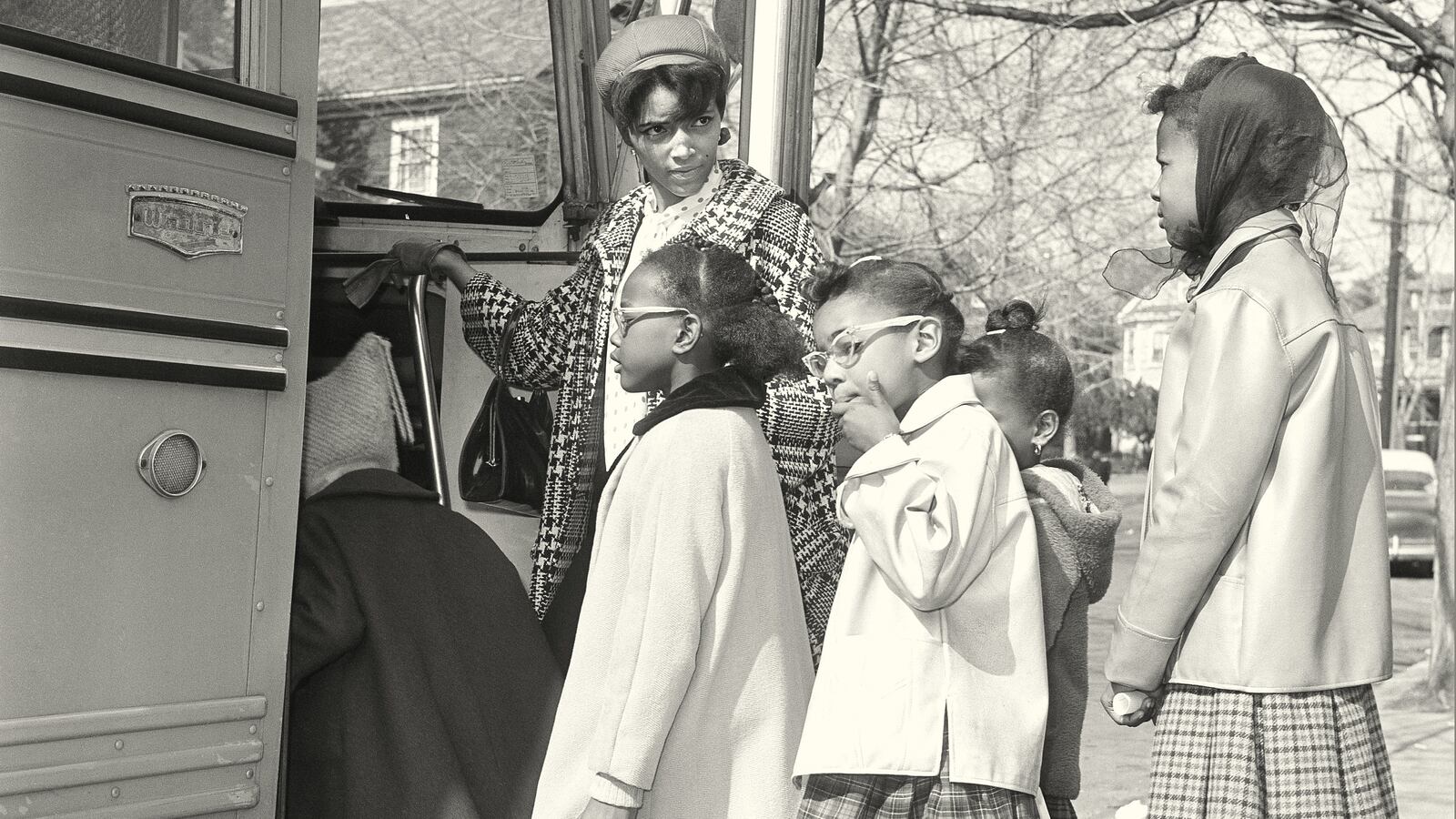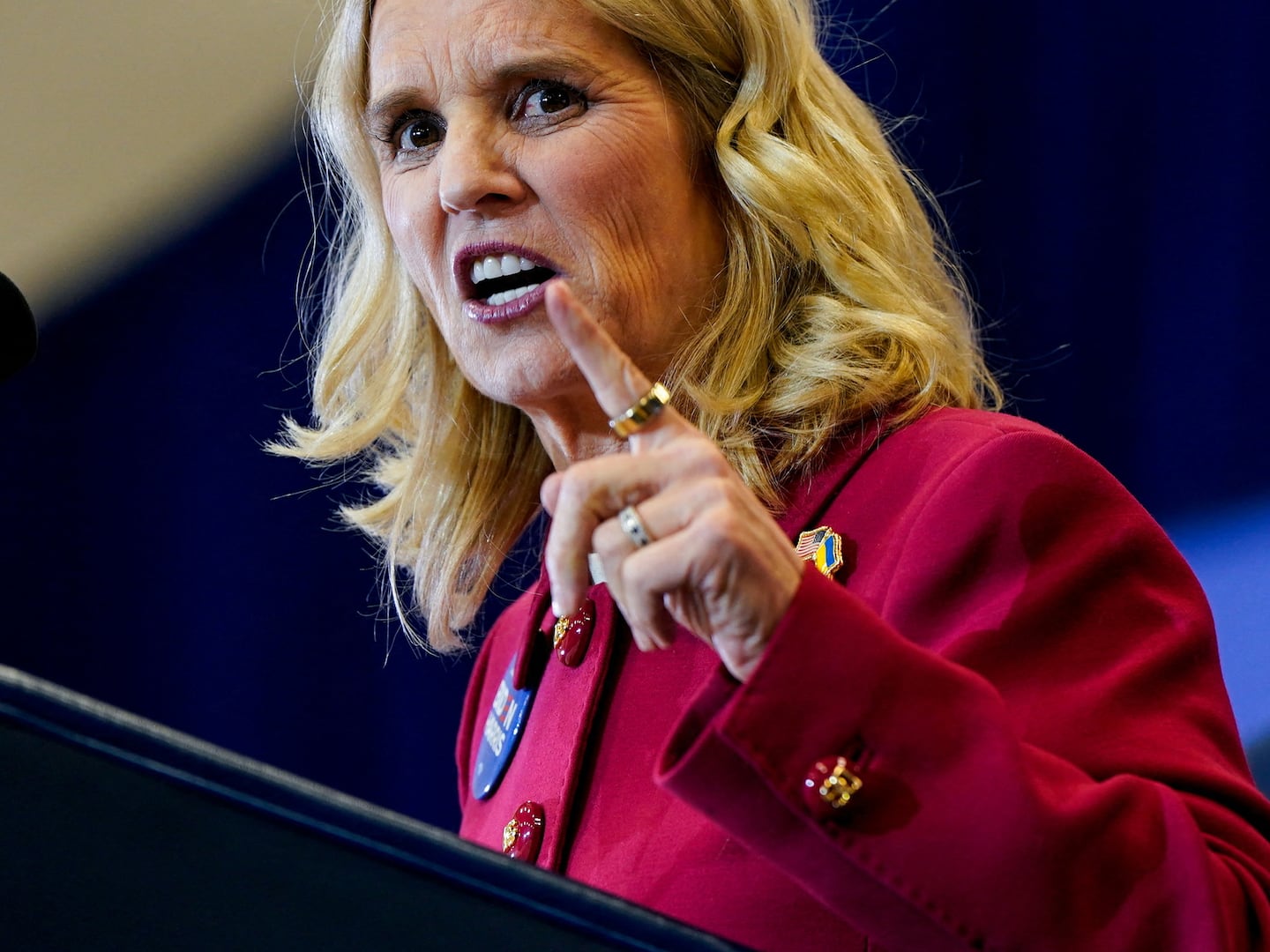“I object to the long arm of the federal government reaching into my home and controlling the children I gave birth to,” Irene McCabe told a reporter as she led a 620-mile protest “mothers’ march” from Michigan to Washington, D.C. in the spring of 1972.
While thousands of parents across the nation raised their voices against busing for school desegregation, none received the same level of national attention as Irene McCabe, a telegenic white housewife from Pontiac.
“She got up on those platforms and you’d think she was born on the stump,” lawyer L. Brooks Patterson noted after McCabe’s death in 2004. McCabe led an antibusing organization called the National Action Group (NAG), whose protests started locally in Pontiac but quickly drew media attention from television news networks. (The gendered connotations of the acronym were intentional, as suggested by a sign on the van that accompanied the group on their march to Washington, D.C.: “If at first you don’t succeed, NAG, NAG, NAG”).
McCabe emerged on the scene at the precise moment that the news media was turning its attention from black civil rights activism to the white “silent majority.” While McCabe did not have any formal media training, she proved skillful at creating media spectacles to advance her political position and she made use of the media strategies that African-American civil rights activists used just years earlier. While her name is not well known today, the ways McCabe framed her resistance to school desegregation still echo in contemporary debates on education, race, and equality.
Born and raised in Pontiac, McCabe claimed to have never traveled south of Detroit before she started protesting busing at the age of 36. Like many other women who became grassroots activists, McCabe, a married mother of three, emphasized her lived experiences as a mother and housewife as the reasons she became involved in politics.
McCabe regularly described herself and her fellow marchers as “ordinary housewives and mothers,” and explained to a Washington Post reporter, “I’m an amateur. When I address people at rallies, if they can relate to me it’s just because they know I’m the same type of person they are, that I am a housewife … just mainstream, grass-roots America.”
McCabe started the National Action Group in spring 1971 after Judge Damon Keith found the Pontiac school board guilty of intentionally segregating the city’s schools and ordered the schools to desegregate. She was a skilled grassroots organizer who was candid about using her physical appearance and sexuality to draw more attention to herself and the antibusing cause. McCabe frequently appeared in tight-fighting T-shirts with the slogan “bus judges, not children” or with a bumper sticker across the chest of her sweater.
“I do these silly things to get attention. We women have to do our share of stirring up people power,” she told a journalist. “Antibusing crusading can’t all be so dour and long-faced.”
McCabe was also a careful student of the Civil Rights movement, even as she was resisting school desegregation. “Martin Luther King walked all over and he got a lot of things done,” McCabe announced at one NAG antibusing rally. McCabe later told the Washington Post that she learned to make demands from “the black militants.” “They’ve won many things, they’ve won their demands … We’ve been losers because we haven’t played the game by the rules that they’ve already set down … I’m playing the game by their rules.”

Among the important strategies McCabe learned from media-savvy civil rights groups was to organize protests as television-friendly events. Her most successful and widely reported event was a 620-mile “mothers’ march” from Pontiac to Washington, D.C. to support a constitutional amendment prohibiting busing. The specific length of the march was selected to recall the antibusing amendment, House Joint Resolution 620, sponsored by New York congressman Norman Lent.
McCabe and five other Pontiac mothers set off on the six-week trek on March 15, 1972, and both print and television reporters noted the event’s historical echoes. “How and why,” one article asked, “did the trim housewife emerge as a national figure emulating the tactics of the civil rights marchers of the ’60s?” At the Pontiac send-off for McCabe and the marching mothers, ABC’s Jim Kincaid noted, “Irene McCabe and her National Action Group have taken a page from other demonstrations in the past. It won’t be the first walk to Washington, but it may be one of the longest.”
In addition to the clear reference to the 1963 March on Washington for Jobs and Freedom, the marchers also made a side trip to Massillon, Ohio, the starting point of Coxey’s Army, a group of unemployed workers who marched on Washington in 1894. A 1967 Mothers’ March on Washington by welfare rights activists, which did not receive extensive media attention, may also have factored into McCabe’s planning. As these historical precedents suggest, McCabe’s “mothers’ march” was designed to be easily recognized as a newsworthy event.
McCabe also understood that Americans love misery. Early in the march, McCabe told a newspaper reporter, “This is not my favorite thing—walking, but hopefully people will look along the way at six miserable women on television and write their congressman in favor of the [antibusing] amendment.” Two weeks into the walk, one marcher had her calves wrapped in bandages, and McCabe noted, “I’m wearing sun glasses to hide the tears.” After particularly hilly terrain in West Virginia, McCabe told a waiting reporter, “When you consider what we’ve been through, it’s amazing. You think your chest is going to pop open, your heart explodes, and then there’s another vicious, vicious hill to climb.”
A photo of McCabe icing her feet accompanied a story on the marching mothers’ arrival in Maryland. Just a day before reaching Washington, McCabe stopped for medical treatment on her feet. “I simply could not bear the pain any longer,” she said. “It has been this way for almost two weeks. Every step, I don’t know for how many days, has just been agony.” The marching mothers’ misery became as much a part of the story as their opposition to busing. The marchers encouraged people to see them as suffering on behalf of other parents. As a sign on the group’s support van declared, “Irene McCabe Is Walking to Washington DC, So Your Children Can Walk to School.”
The Associated Press and United Press International wire services distributed dozens of stories on the march, which appeared in newspapers across the country, and this print media coverage served as advance promotion for the culminating rally when the mothers reached Washington at the end of April 1972. The news reports inspired a group of eight mothers from Richmond, Virginia, to walk 100 miles to join the Pontiac marchers. “Irene McCabe is a national heroine,” said one of the Richmond mothers. “It was a spur of the moment thing, but I figured if she could walk 620 miles from Pontiac, Mich., to Washington, then I could do it from Virginia.”
Television cameras from ABC, CBS, and NBC followed McCabe and the other mothers as they arrived in Washington. McCabe’s speech at the rally picked up theme of misery, connecting the physical pain of the march and the pain of childbirth to the building of an antibusing coalition. McCabe limped visibly as she approached the podium, outfitted with several microphones. “I can’t believe we walked the whole way,” she told the crowd. “I personally have suffered a great deal of pain on this walk. It was far more physically grueling than I ever could have imagined. The only time I have ever been in such pain has been in labor. Whenever you’re in labor, you finally give birth to something beautiful. We’ve labored long and we’ve been through a great deal of pain, but it’s worth it, because we have given birth to the rekindling of the government of the people, by the people, and for the people. Look, you’re here!”
McCabe’s speech drew on familiar themes of motherhood and populism and television news cameras broadcast her rallying cry to millions of viewers. As historian Nathan Irvin Huggins noted in 1978, television cameras “broadcast the sentiments of the white, Pontiac, Michigan, housewife [Irene McCabe] protesting ‘forced busing’ as earnestly as they had the achievement of Mrs. Rosa Parks in the Montgomery bus boycott.”

In their pursuit of television coverage, McCabe benefited from the work of conservative politicians and media commentators who were beginning to hone their claims of liberal media bias. Vice President Spiro Agnew, for example, regularly criticized the media, singling out what he saw as the undue influence and liberal bias of television news. In a 1969 speech in Des Moines, written by Pat Buchanan, Agnew argued that network newscasters “decide what 40 to 50 million Americans will learn of the day’s events in the nation and in the world. We cannot measure this power and influence by the traditional democratic standards, for these men can create national issues overnight … For millions of Americans the network reporter who covers a continuing issue—like … civil rights—becomes, in effect, the presiding judge in a national trial by jury.”
Taking aim at civil rights, black power, and anti-war activists, Agnew also emphasized that television could shape protest tactics. “How many marches and demonstrations would we have,” Agnew asked, “if the marchers did not know that the ever-faithful TV cameras would be there to record their antics for the next news show?” Agnew’s attack on television news prompted thousands of citizens to write similarly critical letters to the mailrooms at ABC, CBS, and NBC. NBC News President Reuven Frank argued that “the Agnew speech shook every broadcasting professional,” while the CBS Washington news director and bureau manager described the speech as sending “shock waves through the mass media.” More broadly, several newsmen shared the sentiment that the news media had given too much attention to minority protests.
“In TV news departments we appear to know a lot about the black minority,” NBC producer Shad Northsheild commented, “It’s the silent majority we must explore. We haven’t done it. We didn’t know it was there!” CBS Morning News anchor Joseph Benti concurred: “We spend so much time on angry blacks, angry youth. But what about that vast forgotten army out there? How many hardworking law-abiding whites are made as hell because their story isn’t being told?” An NBC producer remarked simply, “the audience is becoming bored with Negro stories.” McCabe’s “antibusing” protests, therefore, were welcomed by television networks eager to broadcast more of the white working-class and middle-class citizens President Nixon called the “Silent Majority.”
When Agnew complained that network news “can elevate men from obscurity to national prominence within a week” he was referring to Black Power author and activist Stokely Carmichael, but television news could also propel conservative grassroots activists like Irene McCabe to national prominence. This television coverage prompted a critical editorial in the Christian Science Monitor, which argued, “Giving national prime time and front-page headlines to a group of bellicose ladies has put the emphasis in the wrong place.” Describing the history of school segregation in Pontiac, the editorial argued that the busing order should have been “no sudden surprise” and argued that “for the press and public to try to peg a history of bigotry and tension … on busing is an injustice to the majority who are trying to do their best at the moment to accommodate needed social change.”
While McCabe and the march promoters promised ten thousand people, the Washington Post estimated that only five hundred to eight hundred people attended the antibusing rally. CBS’s Tony Sargent noted drily, “Despite Mrs. McCabe’s dramatic march, today’s turnout was far smaller than expected.” L. Brooks Patterson, NAG’s attorney, expressed his disappointment at the low turnout. “This hillside should have been covered with all your neighbors and friends,” he told the crowd. “They scream the loudest when their children are bused, and they should be here to protest.”
In Michigan, many questioned whether the rally accurately represented public opposition to busing. While the Michigan House of Representatives passed a resolution (by a 61—28 vote) honoring McCabe, calling her “the symbol of tens of millions of people who are opposed to forced busing,” the Detroit Urban League was unconvinced. “With the small rally turnout Mrs. McCabe received in Washington, how can the House assume or even support the notion that Mrs. McCabe represents such a large segment of the American population?” asked Detroit Urban League executive director Francis Kornegay.
For her part, McCabe expressed frustration with the turnout to the Washington Post: “If I can give up a year of my life (to fight busing) why can’t they turn out for a day?” McCabe’s disappointment was no doubt sincere, but it underestimated the march’s success as a media event. The march reportedly cost $7,500 and was paid for by fund-raising in Pontiac and along the parade route. Despite this small budget, it generated daily newspaper reports and television news coverage of the marchers’ departure from Pontiac and their arrival in Washington. Here again, news media, especially television, helped McCabe dramatically scale up her antibusing message. Television news brought McCabe’s rally, which despite a month of advance publicity failed to draw one thousand people, to a national audience of millions of television viewers. By any account, this was an extraordinary return on the time and money McCabe and NAG invested in the march.
The mothers’ march reveals both the limitations and promises of television as a tool for political organizing. Television news asks that citizens view certain people, places, and events as newsworthy but does not necessarily lead to particular political outcomes. Television brought McCabe’s message to millions but moved mere hundreds to join the rally in the nation’s capital. Television’s importance to antibusing politics, however, was more significant and more diffuse that this low turnout suggests.
Television news was never interested in McCabe in and of herself; rather, she drew the attention of television cameras as the leader of a group that organized television-ready protests focused on a specific issue. When the busing battle died down in Pontiac, television shifted from McCabe to antibusing protests in other cities.

Television coverage did not drive massive numbers of people to NAG’s rally in Washington or bring McCabe lasting political power, but it did help thwart school desegregation. In Louisville, Boston, Cleveland, and several other cities, antibusing activists leveraged news media to argue that their rights as parents and homeowners were being violated by activist judges and federal bureaucrats. Likewise, politicians such as Florida governor Claude Kirk, Alabama governor and presidential candidate George Wallace, and President Richard Nixon voiced their opposition to busing in carefully planned events and speeches that played well on television. Support for busing, by contrast, was less organized and less vocal, and when pro-busing events were organized, like the forty-thousand-person march in support of desegregation in Boston in 1975, they received far less television coverage than antibusing protests.
Irene McCabe is the best example of how grassroots groups and politicians used news media to frame the issue of busing and to successfully resist school desegregation. Whereas news media helped underscore the urgency of the black civil rights movement in the South in the ’50s and ’60s, by the mid-’60s and ’70s white antibusing protestors received the vast majority of media attention. “This is our civil rights movement,” McCabe frequently told her white supporters. Framed in this way, the white defense of school segregation in the North looked much more reasonable and justified than similar efforts in the South. “TV didn’t determine the outcome, but it did aid and abet those motivated to destroy integration in any form,” Los Angeles Superior Court Judge Paul Egly said in 1981. “Busing resistance was the story TV could understand. TV didn’t understand the story that was going on in court. They didn’t understand the minority side. There was no story for them there because there were no riots, no pickets, nothing whatsoever but poor education and segregation.” Today, when many school districts are more racially segregated than they were in the ’70s, we are still dealing with the legacies of this history.






